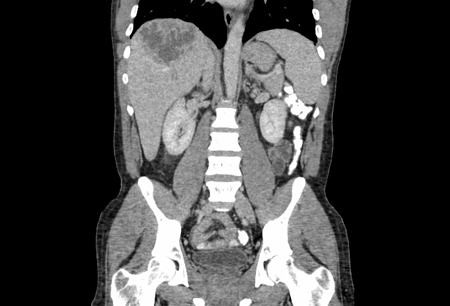Resumen
Definición
Anamnesis y examen
Principales factores de diagnóstico
- presencia de factores de riesgo
- fiebre y escalofríos
- sensibilidad en el cuadrante superior derecho (CSD)
- hepatomegalia
Otros factores de diagnóstico
- pérdida de peso
- fatiga
- dolor abdominal
- náuseas y vómitos
- tos, disnea o dolor torácico
- ictericia
- signos de derrame pleural en la zona inferior derecha
- signos de shock
- ascitis
Factores de riesgo
- enfermedad de las vías biliares
- >50 años de edad
- neoplasia maligna subyacente
- diabetes mellitus
- procedimientos hepáticos o biliares intervencionistas
- vivir en una zona endémica de amebiasis o haberla visitado
- cirrosis
- trasplante de hígado
- alcoholismo
- sexo masculino
- enfermedad cardiopulmonar
- estado inmunocomprometido
- traumatismo abdominal penetrante
- enfermedad inflamatoria del intestino, pancreatitis, apendicitis, diverticulitis o peritonitis
- bacteriemia, endocarditis u otra infección intravascular
- mala dentición
Pruebas diagnósticas
Primeras pruebas diagnósticas para solicitar
- hemograma completo (HC)
- pruebas de función hepática (PFH) séricas
- hemocultivos
- tiempo de protrombina y tiempo de tromboplastina parcial activada
- ecografía hepática
- exploración del abdomen por tomografía computarizada (TC) con contraste
- tinción de Gram y cultivo del líquido del absceso aspirado
Pruebas diagnósticas que deben considerarse
- radiografía del tórax (RT)
- prueba de anticuerpos séricos frente a Entamoeba histolytica
- prueba de detección de antígenos de Entamoeba histolytica en materia fecal
- prueba de antígenos o reacción en cadena de la polimerasa (PCR) del líquido de absceso aspirado
- imagen por resonancia magnética (IRM) del hígado
- proteína C-reactiva
Algoritmo de tratamiento
sospecha de absceso piógeno
sospecha de absceso amebiano
absceso piogénico: después de la respuesta a la terapia de antibióticos intravenosos
absceso amebiano: tras respuesta a la terapia con nitroimidazol
recurrencia del absceso
Colaboradores
Autores
Rachel P. Simmons, MD
Assistant Professor of Medicine
Division of General Internal Medicine
Warren Alpert Medical School of Brown University
Providence
RI
Divulgaciones
RPS declares that she has no competing interests.
Lawrence S. Friedman, MD
Professor of Medicine
Harvard Medical School and Tufts University School of Medicine
Boston
MA
Divulgaciones
LSF has received royalties from Elsevier, Wiley, McGraw-Hill, Harvard Health Publications, Wolters Kluwer, and UpToDate.
Revisores por pares
James Neuberger, BM, BCh
Consultant Physician
Liver Unit
Queen Elizabeth Hospital
Birmingham
UK
Divulgaciones
JN declares that he has no competing interests.
Nancy Reau, MD
Assistant Professor of Medicine
University of Chicago
Center for Liver Disease
Chicago
IL
Divulgaciones
NR declares that she has no competing interests.
Agradecimiento de los revisores por pares
Los temas de BMJ Best Practice se actualizan de forma continua de acuerdo con los desarrollos en la evidencia y en las guías. Los revisores por pares listados aquí han revisado el contenido al menos una vez durante la historia del tema.
Divulgaciones
Las afiliaciones y divulgaciones de los revisores por pares se refieren al momento de la revisión.
Referencias
Artículos principales
Feldman M, Friedman LS, Brandt LJ. Brandt. Sleisenger and fordtran's gastrointestinal and liver disease - 2: pathophysiology, diagnosis, management. 11th ed. Elsevier; 2022.
Artículos de referencia
Una lista completa de las fuentes a las que se hace referencia en este tema está disponible para los usuarios con acceso a todo BMJ Best Practice.

Diferenciales
- Colangitis ascendente
- Cistoadenoma o cistoadenocarcinoma
- Seudotumores inflamatorios de hígado
Más DiferencialesGuías de práctica clínica
- Appropriateness criteria: right upper quadrant pain
- Appropriateness criteria: acute nonlocalized abdominal pain
Más Guías de práctica clínicaFolletos para el paciente
Apendicitis
Más Folletos para el pacienteVideos
Demostración animada de venopunción y flebotomía
Demostración animada de la canulación venosa periférica
Más vídeosInicie sesión o suscríbase para acceder a todo el BMJ Best Practice
El uso de este contenido está sujeto a nuestra cláusula de exención de responsabilidad